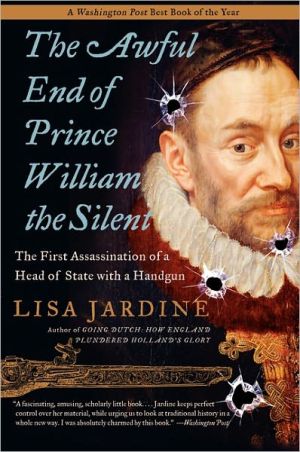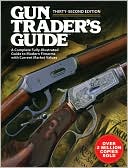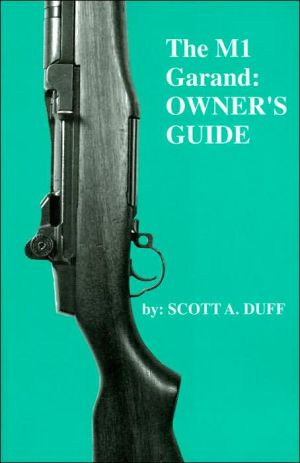Awful End of Prince William the Silent: The First Assassination of a Head of State with a Handgun
The assassination of Prince William of Orange by a French Catholic in 1584 had immediate political consequences and a profound effect on the course of history. It was a serious setback for Protestants in the Netherlands, who were struggling for independence from the Catholic rule of the Hapsburg Empire. But the crime's ramifications were even more earth-shattering, for it heralded the arrival of a new threat to the safety of world leaders and the security of nations: a pistol that could...
Search in google:
The assassination of Prince William of Orange by a French Catholic in 1584 had immediate political consequences and a profound effect on the course of history. It was a serious setback for Protestants in the Netherlands, who were struggling for independence from the Catholic rule of the Hapsburg Empire. But the crime's ramifications were even more earth-shattering, for it heralded the arrival of a new threat to the safety of world leaders and the security of nations: a pistol that could easily be concealed on one's person and employed to a lethal effect at point-blank range.In this provocative, fascinating, and enormously engaging work, noted author and historian Lisa Jardine brilliantly recounts the brazen act of religious terrorism that changed everything--and explores its long and bloody legacy, from the murder of Abraham Lincoln in 1865 to the slaying of Archduke Ferdinand in 1914, to the plague of terror and violent zealotry that infects our world today.The Washington Post - William SeeThese guns, so quick, so appealing, so lethal! They or those like them did away with Abraham Lincoln, Medgar Evers, the Kennedy brothers, Archduke Franz Ferdinand, Martin Luther King Jr., John Lennon and thousands and thousands of ordinary storekeepers, unloved spouses and gangsters. These guns perfectly suit our murderous tendencies and also our senses of bravery, honor, bravado and fun. They're the ultimate democratic weapon: The poorest of us may own one, the most powerful of us may perish from its use. Jardine keeps perfect control over her material, while urging us to look at traditional history in a whole new way. I was absolutely charmed by this book, up to and including the shivering, barelegged nobleman with his goose bumps and his fancy-schmancy wheel-lock pistol.
The Awful End of Prince William the Silent\ The First Assassination of a Head of State with a Handgun \ \ By Lisa Jardine \ HarperCollins Publishers, Inc.\ Copyright © 2007 Lisa Jardine\ All right reserved.\ \ \ \ Chapter One\ How the Prince of Orange\ Came to Have a Price on his Head\ The Protestant prince who fell victim to a Catholic assassin's three bullets in July 1584 had not been destined from birth to lead a nation. When William of Nassau was born in the castle of Dillenburg, in Nassau in Germany, in 1533, nobody could have imagined that he would one day become the greatest of all national heroes remembered in the Netherlands--Holland's 'pater patriae', the 'father' of his adopted country, celebrated down to the present day in the rousing stanzas of the Dutch national anthem.6 The eldest son of William the Rich and Juliana of Stolberg, and a German national, William inherited from his father the comparatively modest title of Count of Nassau. But in 1544 his uncle Rene´ of Chalon, hereditary ruler of the small independent principality of Orange in southern France, died on the battlefield, leaving no direct descendants. Orange was a Habsburg possession. After delicate negotiations between the Habsburg Emperor Charles V (of whose extensive empire the Orange territory ultimately formed a part) and William's father, the eleven-year-old William unexpectedly became heir to the Chalon titles. He was immediately removed from his family home and sent to reside at the ancient seat of the Nassau family in Bredain the Low Countries. From there he could be conveniently introduced into Charles V's court at Antwerp, to be raised in a manner befitting the designated ruler of a Habsburg territory.\ The suddenness of William's elevation, at such a formative moment, left its lasting mark. Throughout his life his reputation was as a man of considered actions and a steady temperament--or, according to his enemies, a man who hedged his bets and would never speak his mind. In the public arena he displayed a combination of humanity, seriousness and personal restraint derived from his early modest upbringing, coupled with an easy ability to operate smoothly in the midst of all the magnificence of European court protocol and the procedural intricacies of diplomacy and power politics. His considerable skill as a negotiator depended on a relaxed familiarity with the forms and ceremonies of international power-broking, acquired during his period in the household of Charles V. Over and over again in the course of the 'Dutch Revolt' these were the skills needed to persuade ill-assorted parties to sign up to a political alliance, to retrieve lost ground by negotiation, or to gain time or a vital truce, in the all-too-evenly balanced conflict in which William became caught up--most probably against his better judgement--and which consumed the last twenty years of his life.\ If William the Silent was not the kind of candidate we might expect for political leadership in the northern Netherlands, neither was he an obvious choice as the leading European protagonist on behalf of the Protestant cause. Although his family was Protestant, he himself was by no means a settled adherent to any sect of the reformed religion by birth or upbringing. One important outcome of the circumstances of his youth was William's complicated attitude towards the religious disputes of the day. During his father's lifetime, the house of Nassau moved closer to the evangelical Protestant princes in Germany. From puberty, however, amid the magnificence of the Catholic Antwerp court of Charles, where the Prince of Orange entered the Council of State on the succession of Philip of Spain as ruler in the Low Countries in 1555, and was elected a Knight of the Order of the Golden Fleece by Philip in August 1559, it was assumed that William would uphold the Catholic confession of his Habsburg imperial masters. And indeed during his early tenure he showed no inclination to do otherwise.\ When Charles V resigned the sovereignty of the Netherlands in 1555 in favour of his son Philip, the ageing Habsburg emperor gave his farewell address to the great assembly in Brussels leaning on the shoulder of Prince William, thereby proclaiming to the world the trust he placed in the young nobleman. Philip II in his turn appointed William governor general or 'stadholder' of the counties of Holland and Zeeland and the land of Utrecht (and other adjacent territories) in 1559, with the task of looking after Habsburg interests in the northern occupied Low Countries territories, and maintaining Philip's 'rights, highness and lordship' there.\ In spite of this careful grooming, William of Orange did not live up to the Habsburgs' hopes for him as a loyal servant and administrator of their imperial rule. Instead, the care that had been taken with his upbringing, and the trust placed in him by Charles V, added emotional intensity to the later confrontations between William and Philip II. Philip considered that William had been privileged to have been succoured and supported by the Habsburgs. When the Prince of Orange subsequently became one of their most prominent and dangerous political opponents, the self-appointed defender of the Protestant faith in the Low Counties which the Habsburgs had pledged themselves to root out as a 'vile heresy', this was, for Philip, a personal betrayal.\ The principality of Orange was, and is, of relatively small importance on the international scene. Then as now, its main claim to fame was its magnificent Roman amphitheatre and triumphal arch, which dominated the town. Nevertheless, it was William's tenure of that Orange title which singled him out for leadership in the struggle of the Low Countries against the Habsburgs. The Princes of Orange were sovereign princes, and thus, in theory, William was of comparable rank to Philip II--King of Spain--himself.William always maintained that his status as prince removed from him the obligation to pay allegiance to Philip as ruler of the Netherlands. Contemporary political theory maintained that those subordinate to a reigning prince might not challenge his authority unless his rule amounted to tyranny. . . .\ \ \ Continues... \ \ \ \ Excerpted from The Awful End of Prince William the Silent by Lisa Jardine Copyright © 2007 by Lisa Jardine. Excerpted by permission.\ All rights reserved. No part of this excerpt may be reproduced or reprinted without permission in writing from the publisher.\ Excerpts are provided by Dial-A-Book Inc. solely for the personal use of visitors to this web site. \ \
\ Jan Morris"Nobody can explain factual history more clearly than Jardine, but the best part of this book concerns more abstract implications."\ \ \ \ \ Omaha World-Herald"Brief, pithy and fascinating... Jardine does justice to an intriguing topic, and the book reads as scholarly without being pedantic."\ \ \ Newsday"Brisk and splendidly told . . . Jardine’s book is popular narrative at its best—quick, sure, detailed and broadly entertaining."\ \ \ \ \ Wall Street Journal"Jardine writes with fluid precision and offers many dashes of historical color."\ \ \ \ \ Deseret Morning News (Salt Lake City)"A lively account of an important historical turning point . . . Thorough and well written."\ \ \ \ \ Washington Post"A fascinating, amusing, scholarly little book... I was absolutely charmed by this book."\ \ \ \ \ William SeeThese guns, so quick, so appealing, so lethal! They or those like them did away with Abraham Lincoln, Medgar Evers, the Kennedy brothers, Archduke Franz Ferdinand, Martin Luther King Jr., John Lennon and thousands and thousands of ordinary storekeepers, unloved spouses and gangsters. These guns perfectly suit our murderous tendencies and also our senses of bravery, honor, bravado and fun. They're the ultimate democratic weapon: The poorest of us may own one, the most powerful of us may perish from its use. Jardine keeps perfect control over her material, while urging us to look at traditional history in a whole new way. I was absolutely charmed by this book, up to and including the shivering, barelegged nobleman with his goose bumps and his fancy-schmancy wheel-lock pistol.\ — The Washington Post\ \ \ \ \ The New YorkerIn 1584, William of Orange, Stadholder of the Low Countries, was shot to death in his home in Delft by a French assassin, Balthasar Gérard, who used a wheel-lock pistol, then a fairly recent invention. Gérard, a Catholic fanatic, had responded to Philip II of Spain’s offer of a twenty-five-thousand-crown reward to anyone who could kill the tolerant Protestant prince, who once remarked that Catholics and Protestants “in principle believed in the same truth, even if they expressed this belief in very different ways.” The threat to security posed by the pistol, lethal and easily concealed, shocked Europe. In England, the possibility of a similar attack on Queen Elizabeth led to increased surveillance, arrests, and interrogations, which, in Jardine’s view, provide a parallel with current reactions to religious terrorism.\ \ \ \ \ Publishers WeeklyWilliam the Silent may be an obscure name for many readers, but his assassination in 1584, at close range with a handgun, is still remembered in the Netherlands as a key event in the long Dutch struggle for independence from Spain. Born to a German family, William inherited a French principality and was raised under the tutelage of the Catholic Emperor Charles V, yet became the "father" of Netherlands Protestant national identity. Jardine (The Curious Life of Robert Hooke) places the assassination within the era's religious turmoil and espionage systems, arguing for its deep repercussions for security, diplomacy and warfare. Her scholarship is broad, as she dissects William's lasting reputation for tolerance as a product of the writings of his supporters and traces the technology, uses and symbolism of the wheel-lock pistol used to kill him. With modern references including 9/11, fatwahs and Tupac Shakur, Jardine demonstrates the pervasiveness of the issues raised both by this type of weapon and by responses to crimes of state. Some readers might wish for a more narrative approach to such a potentially riveting story, but they will enjoy this marvelous study of a single event and its numerous echoes. (Feb. 7) Copyright 2005 Reed Business Information.\ \ \ \ \ Library JournalWilliam I, Prince of Orange (1533-84), known as William the Silent, was a German-born Dutch statesman who, raised a Catholic by order of the Holy Roman Emperor, converted to Protestantism, drove Spain out of the Netherlands, and is credited thus as the founder of Dutch independence. Jardine (Renaissance studies, Queen Mary University, London; The Curious Life of Robert Hooke), seeing that William I is little known in history books outside of Holland, has provided a fascinating account of his place in history: he was the first head of state to be assassinated by a person able to approach him at point-blank range with a concealed and primed weapon, an act that struck terror into the hearts of other heads of state, especially his Protestant ally Queen Elizabeth I. Jardine deftly and efficiently places this event in the political, religious, social, and cultural context of its times. Illustrations, a map, and a genealogical table, together with endnotes make it a worthy study. Her final summary, using Bob Dylan lyrics as the epigraph, ponders the handgun violence that permeates the world today. Recommended for history and handgun sections in public and academic libraries.-Br. Benet Exton, St. Gregory's Univ., Shawnee, OK Copyright 2006 Reed Business Information.\ \ \ \ \ Kirkus ReviewsHow the murder with a handgun of a prince in the 16th century became the shot heard around the world. Like the assassinations of Abraham Lincoln in 1865, Archduke Franz Ferdinand in 1918 and John F. Kennedy in 1963, that of Prince William the Silent in 1584 created a sensation in its day. In her fast-paced account of the murder of the father of an independent Netherlands, historian Jardine (Renaissance Studies/Queen Mary Univ., London; The Curious Life of Robert Hooke, 2004, etc.) charts the religious/political struggle during the 16th century that pitted the Catholic Hapsburgs against Europe's Protestants. Groomed early in life by the Hapsburgs to be a faithful servant, William later changed his allegiance in response to the Spanish persecution of Dutch Protestants. As his conflict with his Dutch subjects intensified, Spain's King Philip II saw the uncooperative William as a traitor and placed a price on his head. Spurred by Philip's appeals, a French Catholic finally silenced the prince with bullets discharged from the latest in deadly technology: a wheel-lock pistol. Jardine successfully illustrates how William's murder unleashed paranoia in England as the Protestant Queen Elizabeth I and her advisers feared for her safety. Her occasional attempts to tie the heated religious disputes of the 16th century with present day troubles can sometimes distract from the narrative, but overall, she succeeds in recreating a snapshot of a long-forgotten event. A slim volume packing plenty of information, and a useful reminder of how a single event-executed in seconds-can have significant historical implications.\ \








